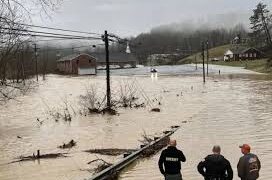At least 10 people have died as severe flooding and heavy rain battered parts of the southeastern United States over the weekend, submerging roads and homes.
Kentucky Governor Andy Beshear confirmed that nine people lost their lives in his state, prompting him to declare a state of emergency. He also reported that around 1,000 people stranded by the floods were rescued. The region is now bracing for drier but colder conditions, with the potential for snow, ice, and further disruptions, according to BBC forecaster John Hutchinson.
The other fatality occurred in Georgia, where a man was killed when an uprooted tree crashed into his home while he was in bed.
Over the weekend, several states, including Kentucky, Georgia, Alabama, Mississippi, Tennessee, Virginia, West Virginia, and North Carolina, were placed under storm-related alerts. Many of these states had already experienced significant damage from Hurricane Helene in September.
The storm left hundreds of thousands of homes without power, though by Monday morning, the number had decreased to tens of thousands, as reported by monitoring site Poweroutage.us. In Kentucky, some areas received up to 6 inches (15 cm) of rain, leading to widespread flooding. The heavy rainfall caused river levels to surge quickly, trapping vehicles in deep water and forcing the closure of numerous roads.
Among the victims in Kentucky were a mother and her 7-year-old child, as well as a 73-year-old man. One resident in flood-stricken Knott County shared his fear of losing everything again, as he was still rebuilding from the catastrophic flooding two years ago. “The flooding I’ve seen in recent years is different,” he said.
Governor Beshear has written to the White House requesting a federal disaster declaration and funding for the affected areas. On Sunday, President Donald Trump approved the declaration, authorizing the Federal Emergency Management Agency (FEMA) to coordinate relief efforts.
In Tennessee’s Obion County, heavy rains caused a levee to breach, leading to rapid flooding in the town of Rives, located along the Obion River. Local footage showed brown floodwaters rushing through the area as rescue teams in boats navigated past submerged homes. Obion County Mayor Steve Carr declared a state of emergency and ordered mandatory evacuations in Rives.
West Virginia Governor Patrick Morrisey also issued a state of emergency in over a dozen counties due to the flooding.
Kristi Noem, head of the Department of Homeland Security (DHS), which oversees FEMA, stated that she had been in contact with the governors of affected states, offering resources and support. “While emergency management is best led by local authorities, we reinforced that DHS stands ready to take immediate action,” she said.
Meanwhile, the same weather system is now bringing heavy snow to parts of Canada. The National Weather Service (NWS) has also warned that arctic air could bring record-breaking cold temperatures and dangerous wind chills to the central United States this week.
Disclaimer: This is an AI-generated live blog and has not been edited by Localtak staff.
Also Read: Sophie Devine to Miss ODIs and T20Is Against Sri Lanka















 Categories
Categories









